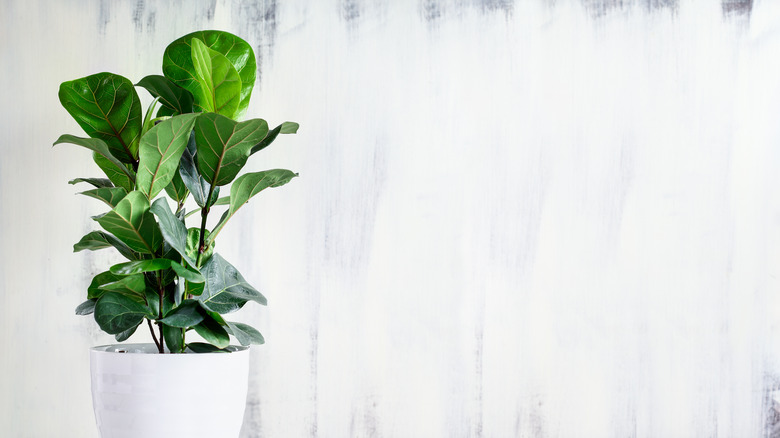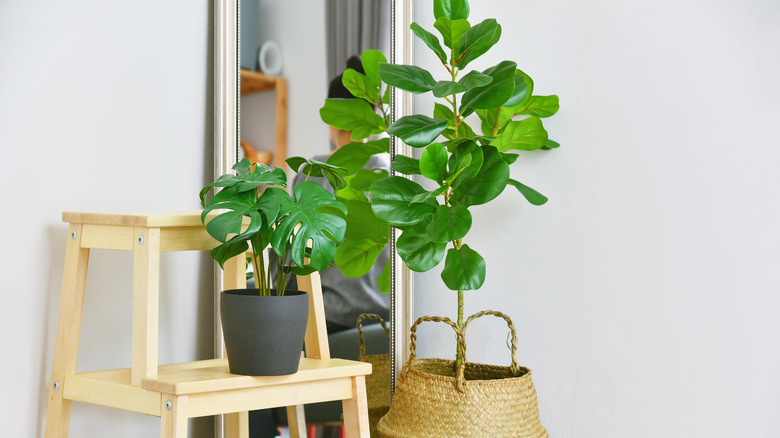Garden Trees, Shrubs & Vines
Tiffany Selvey
With hundreds of thousands of photos devoted to them on Instagram, fiddle leaf figs (Ficus lyrata) are a popular tree that fits any decor style, from boho to modern. Like all indoor plants, fiddle leaf figs have specific requirements to grow and thrive indoors, and that’s the challenge. With prices ranging from around $12 for a small plant to hundreds of dollars for mature trees, this gorgeous greenery can be a significant investment as well as an integral part of your home’s design.
In the right environment, a fiddle leaf fig tree can live up to 50 years, but if you have ever tried to grow one, you might find it challenging to keep it alive for more than a few months. That’s because these plants are incredibly finicky about their living space. They need bright light, but direct sun will scald their leaves. Low-humidity conditions are unacceptable, so your fiddle leaf fig needs a humidifier or regular spritzing. Watering is also challenging because they do not tolerate soggy soil, but their leaves will turn brown quickly if they get too dry. Sometimes it seems like fiddle leaf figs are more of a pet than a plant, but if you can get the space just right, these stunning trees will repay you with large, healthy leaves for many years.
Benefits of fiddle leaf figs

Stephanie Frey/Shutterstock
There’s no argument that fiddle leaf figs add a natural element to any room. Their big, bold leaves are unlike any other houseplant. If you are willing and able to give them the environment they need to thrive, there are many options available. Although some impressive indoor specimens reach up to 10 feet tall, that is not the norm. In fact, fiddle leaf figs come in full and dwarf sizes (also called “Bambinos”). If you need to fill a large, well-lit corner of a room, a full-sized tree is perfect, but if you just want to accent a smaller space, consider a dwarf variety.
Like all houseplants, fiddle leaf figs help purify the room from harmful airborne toxins; the more greenery you have in a space, the cleaner your air. The large surface of each leaf on these trees makes them extra efficient at absorbing toxins and releasing oxygen.
Alternatives

Artfully Photographer/Shutterstock
If you love the look of fiddle leaf figs but cannot provide the environment or care they require, there are some alternatives to consider. Parlor palms (Chamaedorea elegans) are low-maintenance plants that grow up to 5 feet tall and add beautiful greenery and texture to any space. This is also a good option for homes with pets who occasionally nibble the leaves, as they’re non-toxic to cats and dogs. If it’s the big, showy leaves that you love, consider a dieffenbachia. These plants are known for tolerating a wide range of environmental conditions and are easy to find at most garden centers for a reasonable price. However, keep fiddle head figs and dieffenbachia away from children and pets, as they are both considered toxic if consumed.
For those concerned about safety but who still want the look of greenery around the home, consider a faux fiddle leaf fig tree. There are some beautiful options on the market now, like these from Pottery Barn. Of course, a good quality tree will not be cheap, but you can get the exact size and shape you want without all the fussing about trying to keep it alive. Plus, you only have to pay once for the plant you want instead of shelling out big bucks every year or so for a new one.



